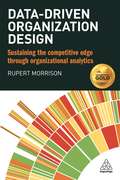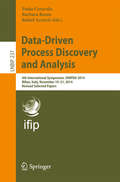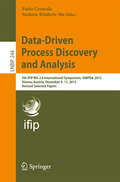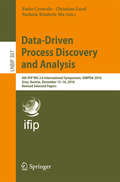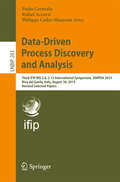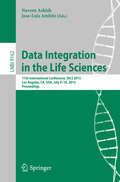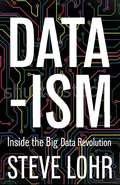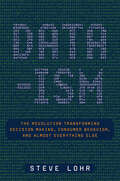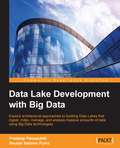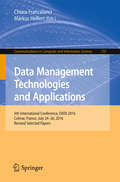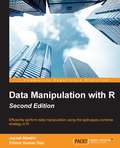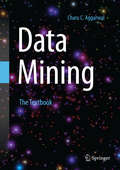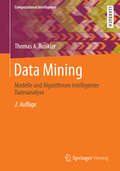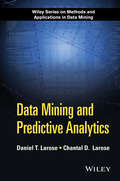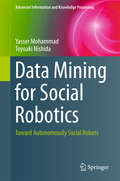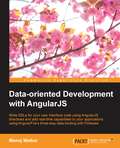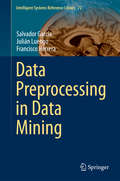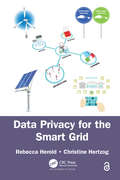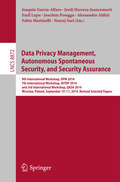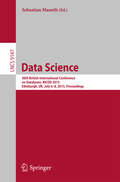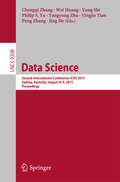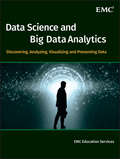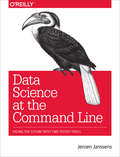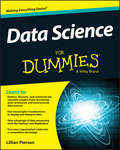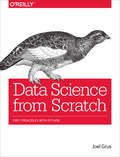- Table View
- List View
Data-driven Organization Design
by Rupert MorrisonData is changing the nature of competition. Making sense of it is tough. Taking advantage of it is tougher. There is a business opportunity for organizations to use data and analytics to transform business performance. Organizations are by their nature complex. They are a constantly evolving system made up of objectives, processes designed to meet those objectives, people with skills and behaviours to do the work required, and all of this organised in a governance structure. It is dynamic, fluid and constantly moving over time. Using data and analytics you can connect all the elements of the system to design an environment for people to perform; an organization which has the right people, in the right place, doing the right things, at the right time. Only when everyone performs to their potential, do organizations have a hope of getting and sustaining a competitive edge. Data-driven Organization Design provides a practical framework for HR and Organization design practitioners to build a baseline of data, set objectives, carry out fixed and dynamic process design, map competencies, and right-size the organization. It shows how to collect the right data, present it meaningfully and ask the right questions of it. Whether looking to implement a long term transformation, large redesign, or a one-off small scale project, this book will show you how to make the most of your organizational data and analytics to drive business performance.
Data-Driven Process Discovery and Analysis: 4th International Symposium, SIMPDA 2014, Milan, Italy, November 19-21, 2014, Revised Selected Papers (Lecture Notes in Business Information Processing #237)
by Barbara Russo Paolo Ceravolo Rafael AccorsiThis book constitutes the thoroughlyrefereed proceedings of the Fourth InternationalSymposium on Data-Driven Process Discovery and Analysis held in Riva del Milan,Italy, in November 2014. The five revised full papers were carefully selected from21 submissions. Following the event, authors weregiven the opportunity to improve their papers with the insights they gainedfrom the symposium. During this edition, the presentations and discussionsfrequently focused on the implementation of process mining algorithms incontexts where the analytical process is fed by data streams. The selectedpapers underline the most relevant challenges identified and propose novelsolutions and approaches for their solution.
Data-Driven Process Discovery and Analysis: 5th IFIP WG 2.6 International Symposium, SIMPDA 2015, Vienna, Austria, December 9-11, 2015, Revised Selected Papers (Lecture Notes in Business Information Processing #244)
by Paolo Ceravolo Stefanie Rinderle-MaThis book constitutes the thoroughlyrefereed proceedings of the Fourth InternationalSymposium on Data-Driven Process Discovery and Analysis held in Riva del Milan,Italy, in November 2014. The five revised full papers were carefully selected from21 submissions. Following the event, authors weregiven the opportunity to improve their papers with the insights they gainedfrom the symposium. During this edition, the presentations and discussionsfrequently focused on the implementation of process mining algorithms incontexts where the analytical process is fed by data streams. The selectedpapers underline the most relevant challenges identified and propose novelsolutions and approaches for their solution.
Data-Driven Process Discovery and Analysis: Second Ifip Wg 2. 6, 2. 12 International Symposium, Simpda 2012, Campione D'italia, Italy, June 18-20, 2012, Revised Selected Papers (Lecture Notes In Business Information Processing #162)
by Paolo Ceravolo Stefanie Rinderle-Ma Christian GuetlThis book constitutes the thoroughlyrefereed proceedings of the Fourth InternationalSymposium on Data-Driven Process Discovery and Analysis held in Riva del Milan,Italy, in November 2014. The five revised full papers were carefully selected from21 submissions. Following the event, authors weregiven the opportunity to improve their papers with the insights they gainedfrom the symposium. During this edition, the presentations and discussionsfrequently focused on the implementation of process mining algorithms incontexts where the analytical process is fed by data streams. The selectedpapers underline the most relevant challenges identified and propose novelsolutions and approaches for their solution.
Data-Driven Process Discovery and Analysis: Third IFIP WG 2.6, 2.12 International Symposium, SIMPDA 2013, Riva del Garda, Italy, August 30, 2013, Revised Selected Papers (Lecture Notes in Business Information Processing #203)
by Paolo Ceravolo Rafael Accorsi Philippe Cudre-MaurouxThis book constitutes the thoroughly refereed proceedings of the Third International Symposium on Data-Driven Process Discovery and Analysis held in Riva del Garda, Italy, in August 2013. The six revised full papers were carefully selected from 18 submissions. Following the event, authors were given the opportunity to improve their papers with the insights they gained from the symposium. The selected papers cover theoretical issues related to process representation, discovery and analysis or provide practical and operational experiences in process discovery and analysis.
Data Integration in the Life Sciences: 11th International Conference, DILS 2015, Los Angeles, CA, USA, July 9-10, 2015, Proceedings (Lecture Notes in Computer Science #9162)
by Naveen Ashish Jose-Luis AmbiteThis book constitutes the proceedings of the 11th International Conference on Data Integration in the Life Sciences, DILS 2015, held in Los Angeles, CA, USA, in July 2015. The 24 papers presented in this volume were carefully reviewed and selected from 40 submissions. They are organized in topical sections named: data integration technologies; ontology and knowledge engineering for data integration; biomedical data standards and coding; medical research applications; and graduate student consortium.
Data-ism: Inside the Big Data Revolution
by Steve LohrCoal, iron ore and oil were the fuel of the Industrial Revolution. Today's economies and governments are powered by something far less tangible: the explosive abundance of digital data.Steve Lohr, the New York Times' chief technology reporter, charts the ascent of Data-ism, the dominating philosophy of the day in which data is at the forefront of everything and decisions of all kinds are based on data analysis rather than experience and intuition. Taking us behind the scenes and introducing the DOPs (Data Oriented-People), the key personalities behind this revolution, he reveals how consuming the bits and bytes of the masses is transforming the nature of business and governance in unforeseen ways. But what are losing in the process and what new dangers await?
Data-ism: The Revolution Transforming Decision Making, Consumer Behavior, and Almost Everything Else
by Steve LohrBy one estimate, 90 percent of all of the data in history was created in the last two years. In 2014, International Data Corporation calculated the data universe at 4.4 zettabytes, or 4.4 trillion gigabytes. That much information, in volume, could fill enough slender iPad Air tablets to create a stack two-thirds of the way to the moon. Now, that's Big Data.Coal, iron ore, and oil were the key productive assets that fueled the Industrial Revolution. The vital raw material of today's information economy is data.In Data-ism, New York Times reporter Steve Lohr explains how big-data technology is ushering in a revolution in proportions that promise to be the basis of the next wave of efficiency and innovation across the economy. But more is at work here than technology. Big data is also the vehicle for a point of view, or philosophy, about how decisions will be—and perhaps should be—made in the future. Lohr investigates the benefits of data while also examining its dark side. Data-ism is about this next phase, in which vast Internet-scale data sets are used for discovery and prediction in virtually every field. It shows how this new revolution will change decision making—by relying more on data and analysis, and less on intuition and experience—and transform the nature of leadership and management. Focusing on young entrepreneurs at the forefront of data science as well as on giant companies such as IBM that are making big bets on data science for the future of their businesses, Data-ism is a field guide to what is ahead, explaining how individuals and institutions will need to exploit, protect, and manage data to stay competitive in the coming years. With rich examples of how the rise of big data is affecting everyday life, Data-ism also raises provocative questions about policy and practice that have wide implications for everyone.The age of data-ism is here. But are we ready to handle its consequences, good and bad?
Data Lake Development with Big Data
by Beulah Salome Purra Pradeep PasupuletiExplore architectural approaches to building Data Lakes that ingest, index, manage, and analyze massive amounts of data using Big Data technologies About This Book * Comprehend the intricacies of architecting a Data Lake and build a data strategy around your current data architecture * Efficiently manage vast amounts of data and deliver it to multiple applications and systems with a high degree of performance and scalability * Packed with industry best practices and use-case scenarios to get you up-and-running Who This Book Is For This book is for architects and senior managers who are responsible for building a strategy around their current data architecture, helping them identify the need for a Data Lake implementation in an enterprise context. The reader will need a good knowledge of master data management, information lifecycle management, data governance, data product design, data engineering, and systems architecture. Also required is experience of Big Data technologies such as Hadoop, Spark, Splunk, and Storm. What You Will Learn * Identify the need for a Data Lake in your enterprise context and learn to architect a Data Lake * Learn to build various tiers of a Data Lake, such as data intake, management, consumption, and governance, with a focus on practical implementation scenarios * Find out the key considerations to be taken into account while building each tier of the Data Lake * Understand Hadoop-oriented data transfer mechanism to ingest data in batch, micro-batch, and real-time modes * Explore various data integration needs and learn how to perform data enrichment and data transformations using Big Data technologies * Enable data discovery on the Data Lake to allow users to discover the data * Discover how data is packaged and provisioned for consumption * Comprehend the importance of including data governance disciplines while building a Data Lake In Detail A Data Lake is a highly scalable platform for storing huge volumes of multistructured data from disparate sources with centralized data management services. It eliminates the need for up-front modeling and rigid data structures by allowing schema-less writes. Data Lakes make it possible to ask complex far-reaching questions to find out hidden data patterns and relationships. This book explores the potential of Data Lakes and explores architectural approaches to building data lakes that ingest, index, manage, and analyze massive amounts of data using batch and real-time processing frameworks. It guides you on how to go about building a Data Lake that is managed by Hadoop and accessed as required by other Big Data applications such as Spark, Storm, Hive, and so on, to create an environment in which data from different sources can be meaningfully brought together and analyzed. Data Lakes can be viewed as having three capabilities--intake, management, and consumption. This book will take readers through each of these processes of developing a Data Lake and guide them (using best practices) in developing these capabilities. It will also explore often ignored, yet crucial considerations while building Data Lakes, with the focus on how to architect data governance, security, data quality, data lineage tracking, metadata management, and semantic data tagging. By the end of this book, you will have a good understanding of building a Data Lake for Big Data. You will be able to utilize Data Lakes for efficient and easy data processing and analytics. Style and approach Data Lake Development with Big Data provides architectural approaches to building a Data Lake. It follows a use case-based approach where practical implementation scenarios of each key component are explained. It also helps you understand how these use cases are implemented in a Data Lake. The chapters are organized in a way that mimics the sequential data flow evidenced in a Data Lake.
Data Management Technologies and Applications: 5th International Conference, DATA 2016, Colmar, France, July 24-26, 2016, Revised Selected Papers (Communications in Computer and Information Science #737)
by Markus Helfert Chiara FrancalanciThis book constitutes the thoroughly refereed proceedings of the Third International Conference on Data Technologies and Applications, DATA 2014, held in Vienna, Austria, in August 2014. The 12 revised full papers were carefully reviewed and selected from 87 submissions. The papers deal with the following topics: databases, data warehousing, data mining, data management, data security, knowledge and information systems and technologies; advanced application of data.
Data Manipulation with R - Second Edition
by Kishor Kumar Das Jaynal AbedinThis book is for all those who wish to learn about data manipulation from scratch and excel at aggregating data effectively. It is expected that you have basic knowledge of R and have previously done some basic administration work with R.
Data Mining: The Textbook (Chapman And Hall/crc Data Mining And Knowledge Discovery Ser. #31)
by Charu C. AggarwalThis textbook explores the different aspects of data mining from the fundamentals to the complex data types and their applications, capturing the wide diversity of problem domains for data mining issues. It goes beyond the traditional focus on data mining problems to introduce advanced data types such as text, time series, discrete sequences, spatial data, graph data, and social networks. Until now, no single book has addressed all these topics in a comprehensive and integrated way. The chapters of this book fall into one of three categories: Fundamental chapters: Data mining has four main problems, which correspond to clustering, classification, association pattern mining, and outlier analysis. These chapters comprehensively discuss a wide variety of methods for these problems. Domain chapters: These chapters discuss the specific methods used for different domains of data such as text data, time-series data, sequence data, graph data, and spatial data. Application chapters: These chapters study important applications such as stream mining, Web mining, ranking, recommendations, social networks, and privacy preservation. The domain chapters also have an applied flavor. Appropriate for both introductory and advanced data mining courses, Data Mining: The Textbook balances mathematical details and intuition. It contains the necessary mathematical details for professors and researchers, but it is presented in a simple and intuitive style to improve accessibility for students and industrial practitioners (including those with a limited mathematical background). Numerous illustrations, examples, and exercises are included, with an emphasis on semantically interpretable examples. Praise for Data Mining: The Textbook - "As I read through this book, I have already decided to use it in my classes. This is a book written by an outstanding researcher who has made fundamental contributions to data mining, in a way that is both accessible and up to date. The book is complete with theory and practical use cases. It's a must-have for students and professors alike!" -- Qiang Yang, Chair of Computer Science and Engineering at Hong Kong University of Science and Technology "This is the most amazing and comprehensive text book on data mining. It covers not only the fundamental problems, such as clustering, classification, outliers and frequent patterns, and different data types, including text, time series, sequences, spatial data and graphs, but also various applications, such as recommenders, Web, social network and privacy. It is a great book for graduate students and researchers as well as practitioners. " -- Philip S. Yu, UIC Distinguished Professor and Wexler Chair in Information Technology at University of Illinois at Chicago
Data Mining: Modelle und Algorithmen intelligenter Datenanalyse (Computational Intelligence)
by Thomas A. RunklerDieses Lehrbuch behandelt die wichtigsten Methoden zur Erkennung und Extraktion von ,,Wissen" aus numerischen und nicht-numerischen Datenbanken in Technik und Wirtschaft. Der Autor vermittelt einen kompakten und zugleich fundierten #65533;berblick #65533;ber die verschiedenen Methoden sowie deren Zielsetzungen und Eigenschaften. Dadurch werden Leser bef#65533;higt, Data Mining eigenst#65533;ndig anzuwenden.
Data Mining and Predictive Analytics
by Daniel T. Larose Chantal D. LaroseLearn methods of data analysis and their application to real-world data sets This updated second edition serves as an introduction to data mining methods and models, including association rules, clustering, neural networks, logistic regression, and multivariate analysis. The authors apply a unified "white box" approach to data mining methods and models. This approach is designed to walk readers through the operations and nuances of the various methods, using small data sets, so readers can gain an insight into the inner workings of the method under review. Chapters provide readers with hands-on analysis problems, representing an opportunity for readers to apply their newly-acquired data mining expertise to solving real problems using large, real-world data sets. Data Mining and Predictive Analytics, Second Edition: Offers comprehensive coverage of association rules, clustering, neural networks, logistic regression, multivariate analysis, and R statistical programming language Features over 750 chapter exercises, allowing readers to assess their understanding of the new material Provides a detailed case study that brings together the lessons learned in the book Includes access to the companion website, www.dataminingconsultant, with exclusive password-protected instructor content Data Mining and Predictive Analytics, Second Edition will appeal to computer science and statistic students, as well as students in MBA programs, and chief executives. rose is a Ph.D. candidate in Statistics at the University of Connecticut. Her research focuses on the imputation of missing data and model-based clustering. She has taught undergraduate statistics since 2011, and is a statistical consultant for DataMiningConsultant.com, LLC.
Data Mining for Social Robotics: Toward Autonomously Social Robots (Advanced Information and Knowledge Processing #0)
by Yasser Mohammad Toyoaki NishidaThis book explores an approach to social robotics based solely on autonomous unsupervised techniques and positions it within a structured exposition of related research in psychology, neuroscience, HRI, and data mining. The authors present an autonomous and developmental approach that allows the robot to learn interactive behavior by imitating humans using algorithms from time-series analysis and machine learning. The first part provides a comprehensive and structured introduction to time-series analysis, change point discovery, motif discovery and causality analysis focusing on possible applicability to HRI problems. Detailed explanations of all the algorithms involved are provided with open-source implementations in MATLAB enabling the reader to experiment with them. Imitation and simulation are the key technologies used to attain social behavior autonomously in the proposed approach. Part two gives the reader a wide overview of research in these areas in psychology, and ethology. Based on this background, the authors discuss approaches to endow robots with the ability to autonomously learn how to be social. Data Mining for Social Robots will be essential reading for graduate students and practitioners interested in social and developmental robotics.
Data-oriented Development with AngularJS
by Manoj WaikarThis book helps beginner-level AngularJS developers organize AngularJS applications by discussing important AngularJS concepts and best practices. If you are an experienced AngularJS developer but haven't written directives or haven't created custom HTML controls before, then this book is ideal for you.
Data Preprocessing in Data Mining (Intelligent Systems Reference Library #72)
by Francisco Herrera Salvador García Julián LuengoData Preprocessing for Data Mining addresses one of the most important issues within the well-known Knowledge Discovery from Data process. Data directly taken from the source will likely have inconsistencies, errors or most importantly, it is not ready to be considered for a data mining process. Furthermore, the increasing amount of data in recent science, industry and business applications, calls to the requirement of more complex tools to analyze it. Thanks to data preprocessing, it is possible to convert the impossible into possible, adapting the data to fulfill the input demands of each data mining algorithm. Data preprocessing includes the data reduction techniques, which aim at reducing the complexity of the data, detecting or removing irrelevant and noisy elements from the data. This book is intended to review the tasks that fill the gap between the data acquisition from the source and the data mining process. A comprehensive look from a practical point of view, including basic concepts and surveying the techniques proposed in the specialized literature, is given. Each chapter is a stand-alone guide to a particular data preprocessing topic, from basic concepts and detailed descriptions of classical algorithms, to an incursion of an exhaustive catalog of recent developments. The in-depth technical descriptions make this book suitable for technical professionals, researchers, senior undergraduate and graduate students in data science, computer science and engineering.
Data Privacy for the Smart Grid
by Rebecca Herold Christine HertzogPrivacy for the Smart Grid provides easy-to-understand guidance on data privacy issues and the implications for creating privacy risk management programs, along with privacy policies and practices required to ensure Smart Grid privacy. It addresses privacy in electric, natural gas, and water grids from two different perspectives of the topic, one from a Smart Grid expert and another from a privacy and information security expert. While considering privacy in the Smart Grid, the book also examines the data created by Smart Grid technologies and machine-to-machine applications.
Data Privacy Management, Autonomous Spontaneous Security, and Security Assurance: 9th International Workshop, DPM 2014, 7th International Workshop, SETOP 2014, and 3rd International Workshop, QASA 2014, Wroclaw, Poland, September 10-11, 2014. Revised Selected Papers (Lecture Notes in Computer Science #8872)
by Alessandro Aldini Fabio Martinelli Joaquin Garcia-Alfaro Neeraj Suri Jordi Herrera-Joancomartí Emil Lupu Joachim PoseggaThis book constitutes the revised selected papers of the 9th International Workshop on Data Privacy Management, DPM 2014, the 7th International Workshop on Autonomous and Spontaneous Security, SETOP 2014, and the 3rd International Workshop on Quantitative Aspects in Security Assurance, held in Wroclaw, Poland, in September 2014, co-located with the 19th European Symposium on Research in Computer Security (ESORICS 2014). The volume contains 7 full and 4 short papers plus 1 keynote talk from the DPM workshop; 2 full papers and 1 keynote talk from the SETOP workshop; and 7 full papers and 1 keynote talk from the QASA workshop - selected out of 52 submissions. The papers are organized in topical sections on data privacy management; autonomous and spontaneous security; and quantitative aspects in security assurance.
Data Science: 30th British International Conference on Databases, BICOD 2015, Edinburgh, UK, July 6-8, 2015, Proceedings (Lecture Notes in Computer Science #9147)
by Sebastian ManethThis book constitutes the refereed conference proceedings of the 30th British International Conference on Databases, BICOD 2015 - formerly known as BNCOD (British National Conference on Databases) - held in Edinburgh, UK, in July 2015. The 19 revised full papers, presented together with three invited keynotes and three invited lectures were carefully reviewed and selected from 37 submissions. Special focus of the conference has been "Data Science" and so the papers cover a wide range of topics related to databases and data-centric computation.
Data Science: Second International Conference, ICDS 2015, Sydney, Australia, August 8-9, 2015, Proceedings (Lecture Notes in Computer Science #9208)
by Yong Shi Yingjie Tian Philip S. Yu Peng Zhang Chengqi Zhang Wei Huang Yangyong Zhu Jing HeThis book constitutes the refereed proceedings of theSecond International Conference on Data Science, ICDS 2015, held in Sydney,Australia, during August 8-9, 2015. The 19 revised full papers and 5 short papers presentedwere carefully reviewed and selected from 31 submissions. The papers focus onthe following topics: mathematical issues in data science; big data issues andapplications; data quality and data preparation; data-driven scientificresearch; evaluation and measurement in data service; big data mining andknowledge management; case study of data science; social impacts of datascience.
Data Science and Big Data Analytics: Discovering, Analyzing, Visualizing and Presenting Data
by Emc Education ServicesData Science and Big Data Analytics is about harnessing the power of data for new insights. The book covers the breadth of activities and methods and tools that Data Scientists use. The content focuses on concepts, principles and practical applications that are applicable to any industry and technology environment, and the learning is supported and explained with examples that you can replicate using open-source software.This book will help you:Become a contributor on a data science teamDeploy a structured lifecycle approach to data analytics problemsApply appropriate analytic techniques and tools to analyzing big dataLearn how to tell a compelling story with data to drive business actionPrepare for EMC Proven Professional Data Science Certification
Data Science at the Command Line
by Jeroen JanssensThis hands-on guide demonstrates how the flexibility of the command line can help you become a more efficient and productive data scientist. You'll learn how to combine small, yet powerful, command-line tools to quickly obtain, scrub, explore, and model your data.To get you started--whether you're on Windows, OS X, or Linux--author Jeroen Janssens introduces the Data Science Toolbox, an easy-to-install virtual environment packed with over 80 command-line tools.Discover why the command line is an agile, scalable, and extensible technology. Even if you're already comfortable processing data with, say, Python or R, you'll greatly improve your data science workflow by also leveraging the power of the command line.Obtain data from websites, APIs, databases, and spreadsheetsPerform scrub operations on plain text, CSV, HTML/XML, and JSONExplore data, compute descriptive statistics, and create visualizationsManage your data science workflow using DrakeCreate reusable tools from one-liners and existing Python or R codeParallelize and distribute data-intensive pipelines using GNU ParallelModel data with dimensionality reduction, clustering, regression, and classification algorithms
Data Science For Dummies
by Lillian PiersonDiscover how data science can help you gain in-depth insight into your business - the easy way! Jobs in data science abound, but few people have the data science skills needed to fill these increasingly important roles in organizations. Data Science For Dummies is the perfect starting point for IT professionals and students interested in making sense of their organization's massive data sets and applying their findings to real-world business scenarios. From uncovering rich data sources to managing large amounts of data within hardware and software limitations, ensuring consistency in reporting, merging various data sources, and beyond, you'll develop the know-how you need to effectively interpret data and tell a story that can be understood by anyone in your organization. Provides a background in data science fundamentals before moving on to working with relational databases and unstructured data and preparing your data for analysis Details different data visualization techniques that can be used to showcase and summarize your data Explains both supervised and unsupervised machine learning, including regression, model validation, and clustering techniques Includes coverage of big data processing tools like MapReduce, Hadoop, Dremel, Storm, and Spark It's a big, big data world out there - let Data Science For Dummies help you harness its power and gain a competitive edge for your organization.
Data Science from Scratch: First Principles with Python
by Joel GrusData science libraries, frameworks, modules, and toolkits are great for doing data science, but they're also a good way to dive into the discipline without actually understanding data science. In this book, you'll learn how many of the most fundamental data science tools and algorithms work by implementing them from scratch.If you have an aptitude for mathematics and some programming skills, author Joel Grus will help you get comfortable with the math and statistics at the core of data science, and with hacking skills you need to get started as a data scientist. Today's messy glut of data holds answers to questions no one's even thought to ask. This book provides you with the know-how to dig those answers out.Get a crash course in PythonLearn the basics of linear algebra, statistics, and probability--and understand how and when they're used in data scienceCollect, explore, clean, munge, and manipulate dataDive into the fundamentals of machine learningImplement models such as k-nearest Neighbors, Naive Bayes, linear and logistic regression, decision trees, neural networks, and clusteringExplore recommender systems, natural language processing, network analysis, MapReduce, and databases
